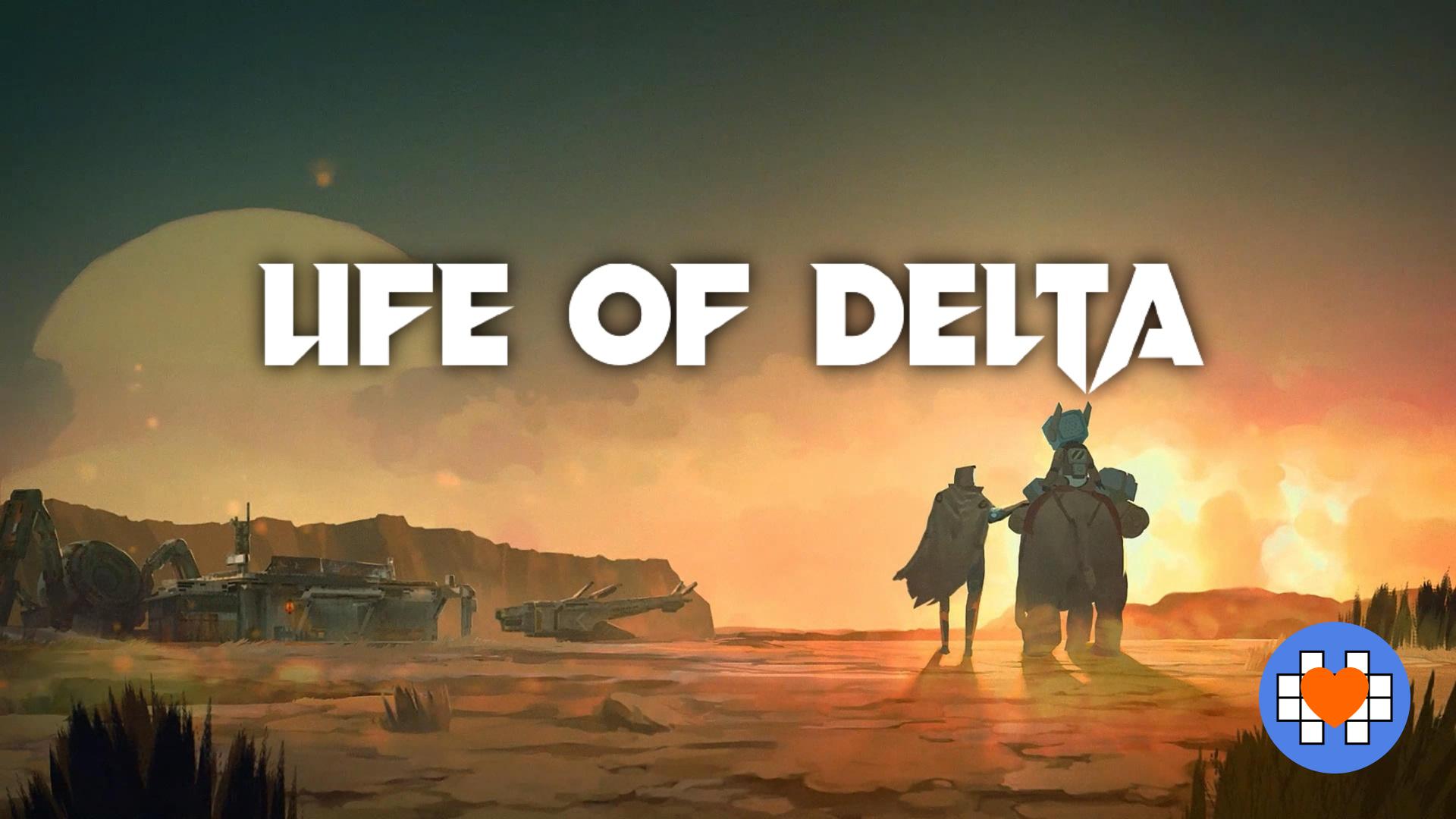In Life of Delta, a small service robot seeks to save his friend in a dystopian and apocalyptic setting marked by oppression and violence.
Released on March 13, 2023, Life of Delta is a delightful point-and-click adventure that I am discussing with guilty delay but with genuine enthusiasm.
Created by Samuel Lorincik, developed by Airo Games – founded by Lorincik himself – and produced by Daedalic Entertainment, Life of Delta tells the story of a small robot who soon embarks on dangerous adventures in a post-apocalyptic world.
Following in the footsteps of significant works like Pixar Animation Studios’ Wall-E, co-produced with Walt Disney Pictures, Life of Delta also introduces an innocent, “good-hearted” little robot. This character once again encourages us to reflect on themes such as artificial intelligence and machine consciousness, and how these traits are often linked to apocalyptic visions where humans end up being overpowered.

The Adventurous Life of Delta
As mentioned, we find ourselves in a dystopian context where there is no trace of humans, and robots inhabit the desolate lands of a ruined world.
As in any science fiction story about them, the machines exist primarily to perform certain tasks. Thus, robots will perform functions such as maintenance, cleaning, control, and various other services, including serving as a portable battery used on construction sites.
The “Delta” series consists of small service robots with excellent repair capabilities for mechanical and electronic objects, and our protagonist is one of them.


Saved from decommissioning by the scientist robot Joe, Delta, who until then worked as a service robot in a Megacity factory, becomes an important friend and life companion, just as Joe becomes for the little robot.
However, their tender and positive story soon takes a terrible turn when, because of what Joe did – saving a robot from decommissioning – agents take him from his home and presumably punish him for his crime.
Delta finds himself alone and worried about his friend. He decides to go in search of Joe, stepping out of his shell and into a hostile and complicated world.


But why is this world so hostile? And who are the agents who took Joe away?
From what we see, the world has fallen into the clutches of the Lizards, biological creatures with threatening appearances, resembling both reptiles and, for example, boars or warthogs, with large tusks, leather clothes, and punk crests reminiscent of Mad Max or Fist of the North Star (Hokuto no Ken), indulging in smoking, drinking, and with a fierce nature.
Most likely, before their arrival, humans had already disappeared, and in this new scenario, robots, enslaved by the Lizards, must survive and endure all kinds of abuse. In such a climate of tension and oppression, even the robots wage war against each other, driven mainly by fear.
But Delta is obviously different and will try to get along with every individual he meets along his journey, which will involve a series of favor exchanges, allowing our little hero to continue his quest and find his beloved Joe.


Apocalyptic Entertainment
How will a small service robot face all these dangers, defeat the terrible Lizards, thwart their plans for conquest, and most importantly, save his friend?
First of all, by using the skills at his disposal, such as repairing mechanical objects and other items like the Bertha aircraft, provided by the Drifter, to fly over the vast desert area. As he heads toward Megacity, he encounters not just irritating and coarse sand that is not robot-friendly, but also dangerous creatures populating the area.
This translates, practically, into a series of highly entertaining and not overly complex puzzles – more than fifty – that encourage the player to engage in logical thinking and observation skills.


The gameplay, being a point-and-click, is not overly elaborate. However, the game design is truly well done: balanced and especially engaging. Once started, it will be very hard to stop. Fortunately, the game’s duration is not excessive. Personally, it took me three hours because I often lingered longer than necessary on some points.
Despite its short duration, the story of Life of Delta is satisfying, complete, and rich with interesting elements and themes, but most importantly, it includes fun “games” that sometimes go beyond simple puzzles, such as cooking and preparing sushi dishes, “playing” in a band Guitar Hero style, or treating wounds.


A Warm and Inhospitable World
Life of Delta, being a point-and-click game, does not require particularly elaborate animations. However, the graphic work done, with the drawings and the use of lights and colors, really makes a difference.
The story charms, compels, and is full of positive messages, but it cannot be said to be particularly original. The graphics, on the other hand, give Life of Delta the uniqueness that I often mention when we come across a product born as an independent project, from the hand and often the mind, of one or a few individuals.


In Life of Delta, there is expressiveness given by the style with which the characters are drawn and the atmospheres created, bringing to life desolate and sun-baked landscapes, but also linear and well-maintained structures. The chaos has its mechanical order, and everything is very “cute” but rough at the same time.
So, kudos to Ho Huynh for the excellent work in character creation, and to Son Truong Nguyen for the work on creating the environments. They have fused skills and visions and made Life of Delta a considerable work, especially thanks to its aesthetic aspect.


Robots and Love
Life of Delta also delves into how machines endowed with consciousness can experience emotions and love.
The creator-created relationship often mirrors that of parent-child – a concept popularized by Mary Shelley’s Frankenstein. Even though Life of Delta presents Joe, not as Delta’s creator but as his savior, it conveys a sense of filial love, akin to Battle Angel Alita. In this manga by Yukito Kishiro, later turned into an animated series and recently a film, the human scientist Ido saves a semi-destroyed cyborg from a junkyard, adopts her, and treats her like a daughter, bringing the character Alita to life.

This initial love between savior or creator and creature often evolves into a broader sense of love, and in some cases, into a romantic relationship. For instance, in Cookie Cutter, scientist Shinji creates Cherry, who, once mature, becomes her partner.
Similarly, Alasdair Gray’s Poor Things, recently adapted to film by Yorgos Lanthimos, delves into this theme. Here, the creator starts with the premise that his creature – though not mechanical but biological like in Frankenstein – will become his companion, initially attempting to transform the father-daughter relationship into a romantic one.
And the Humans?
Interestingly, in Life of Delta, the distinction between humans and robots is quite clear, and not just due to their inherent nature. Towards the end of Life of Delta, we encounter a human, imprisoned by the Lizards in the same facility where Joe is held – the Army Base. The first thing this human asks Delta is whether he intends to harm him, indicating that the Lizards are not the only enemies of humans and suggesting that humans may have gone extinct due to a previous conflict with robots.
This human, imprisoned like other scientists, is simply referred to as “human.” Unlike the robots, who have names and identities based on their functions, he lacks a specific identity. While it makes sense to identify the only present human with the simple label “human,” the feeling I got is that there’s a deliberate writing choice to depersonalize humans in favor of the robots, whose personalities, emotions, fears, and thoughts are much more prominent.

This emphasis on the personality and life of robots is not new, as seen in video games like Detroit: Become Human or Stray, and in films like Chappie or the aforementioned Wall-E.
In Life of Delta, however, the word “life” associated with a machine is quite emblematic, especially when dealing with work machines for which consciousness wouldn’t be particularly useful.
This is not to suggest that the authors intended to highlight how robots are better than humans. On the contrary, a robot saves a human, but the latter behaves in the most honest and cooperative way possible, initiating an alliance aimed at freeing both from the dominion of a fundamentally evil race – the Lizards in this case.
Behind the Scenes
Airo Games comprises a group of young artists, programmers, designers, sound designers, and composers – such as the talented Nikola Jeremic, who excelled on Life of Delta – from the United Kingdom, Slovakia, Poland, and Vietnam. Passionate about science fiction and storytelling since childhood, the team members have been playing video games and have continued to cultivate this passion. Their greatest satisfaction comes from being able to share their talent and use it to tell interesting, adventurous, and, most importantly, fun stories.
In 2017, the adventure began, and gradually Delta and his world started to take shape. After years of hard work, on March 26, 2021, Airo Games announced their partnership with Daedalic Entertainment, and finally, Life of Delta officially came to “life.”
On June 6, 2024, Samuel Lorincik announced the nomination of Life of Delta for the Central & Eastern European Game Awards (CEEGA) in the Visual Art category, with the event scheduled during the Game Industry Conference (GIC) in Poznań, Poland.

Conclusions
Life of Delta is a fun and exciting point-and-click adventure in which a small service robot braves a hostile world to save his friend. It is truly entertaining and highly enjoyable. Light, pleasant, never too complex, though some puzzles are more challenging than others.
In Delta’s story, robots represent humanity in a philosophical sense – defined by aspects such as self-awareness and morality – as they become victims of biological creatures embodying evil.
Graphically original and impeccably executed, it also features music perfectly suited to the context and mood of the game, never overwhelming or “intrusive,” but stylishly and pleasantly complementing the entire experience.
Nostalgic references, quotes, and tributes to a significant past are also present, such as the Gameboy and VHS found in a box, or the arcade cabinet of a classic game like Pong, which we will find ourselves playing near the Army Base in a face-off with an arrogant lieutenant.


“Life of Delta is a captivating point-and-click adventure where a small robot, Delta, navigates a dystopian hostile world to save his friend. The game is light, fun, and enjoyable, featuring stimulating and engaging puzzles. The storyline delves into philosophical themes such as the consciousness and morality of artificial intelligences, and the urgent need to escape from a state of oppression and unbearable slavery at the hands of evil creatures. With original and flawless graphics, accompanied by well-integrated music, Life of Delta offers an immersive experience enriched with nostalgic references and tributes to the video game past.”
- Original and technically impeccable graphics
- Pleasant music, never intrusive and perfectly fitting the context
- Entertaining and engaging puzzles
- Well-written and emotional story
- Clicking on a hotspot can sometimes be challenging
- Controller sensitivity needs to be kept low to easily reach the hotspot

8/10

